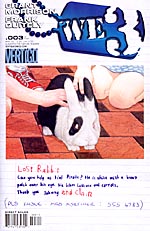 Written by Grant Morrison
Written by Grant Morrison
Art by Frank Quitely
40 pages each, color
Published by Vertigo/DC Comics
With so many comics being published every month, it’s easy for a stray mini-series to pass people by, even though it’s by creators with pretty big name recognition. I can only assume it’s why the top-selling comic this winter hasn’t been Grant Morrison’s and Frank Quitely’s We3.
The military have created a new type of soldier, one that can be sent into almost any situation. They’re living weapons, you see, with remote-controls to activate their implements of destruction. The core of these new weapons, though, are animals that are hardwired into battle suits. It’s easy to think of them as dumb creatures who don’t really know what’s happening to them. They do understand, though… and when their project is shut down and they’re scheduled for termination, a dog, a cat, and a rabbit begin a desperate bid for freedom, one that can never be allowed to succeed lest the project be exposed.
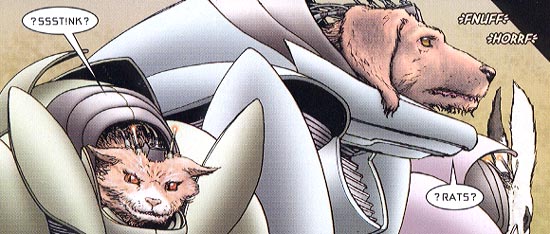
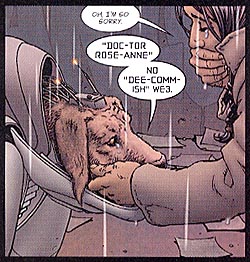 Morrison’s best writing in comics has always had a strong emotional core, one that he uses to manipulate the feelings of the readers. Never before have I seen him succeed so well as he does in We3. Maybe it’s because he’s using family pets as the trapped protagonists of the series, led by an affable dog code-named 1 for whom it’s hard to not care for. The animals speak in crude, broken language, with 1 wanting to know if he’s been a good dog. The base display of their thoughts and emotions—1 wanting to be good, 2 (the cat) distrusting everything around them, and 3 (the rabbit) not really comprehending the gravity of the situation—works because Morrison is able to not only make the core of their being their driving purpose to survive, but he lets the animals struggle to keep their natures intact even as the military tries to destroy them.
Morrison’s best writing in comics has always had a strong emotional core, one that he uses to manipulate the feelings of the readers. Never before have I seen him succeed so well as he does in We3. Maybe it’s because he’s using family pets as the trapped protagonists of the series, led by an affable dog code-named 1 for whom it’s hard to not care for. The animals speak in crude, broken language, with 1 wanting to know if he’s been a good dog. The base display of their thoughts and emotions—1 wanting to be good, 2 (the cat) distrusting everything around them, and 3 (the rabbit) not really comprehending the gravity of the situation—works because Morrison is able to not only make the core of their being their driving purpose to survive, but he lets the animals struggle to keep their natures intact even as the military tries to destroy them.
In many ways, We3 is a terrifying update of The Incredible Journey; it’s an attempt for three animals to go home no matter what’s thrown into their path. On a superficial level, We3 is so much more than that thanks to the military’s usage of the other animals that were created, like an army of rats that can attack in unison, or the horrifying killer that is “We4”. It’s more than that, though, because in We3 this journey “home” is in many ways not only a geographic trip, but a biological one. They’ve not only been taken from their families, but they’ve been taken away from their animalistic nature. Even if they can find their way back to the buildings they came from, can they also return to what they physically and mentally once were? It’s a troubling question that weighs heavily over the pages of We3, and it’s hard to not be unsettled by the possible answers that must ultimately be answered.
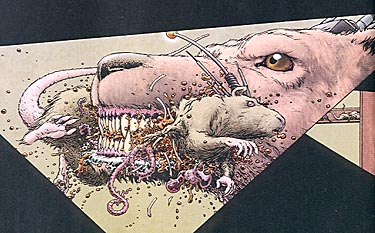 Quitely’s art is at its finest in We3, both in figure composition and in storytelling. Each character is carefully detailed in We3; there’s no shying away from what’s been done to these animals. Quitely has them encased in suits of metal that clank and slide around their bodies; it’s made them ungainly to the eye, a startling contrast to the normally sleek forms of these animals. It’s this careful attention to detail, a deliberate creation of every image designed to intrigue and disturb, that carries through We3. When 1 is forced to attack one of the enhanced rats, you see 1’s teeth cutting through the rodent body, but the bone shards and blood drops that explode aren’t just gratuitous; Quitely is reminding us through the art that these rats are ultimately just as deserving to live and be free of mankind’s tinkering as the three escaping pets of We3. Quitely makes sure that we never forget what the military in this story did, that these are animals and not weapons.
Quitely’s art is at its finest in We3, both in figure composition and in storytelling. Each character is carefully detailed in We3; there’s no shying away from what’s been done to these animals. Quitely has them encased in suits of metal that clank and slide around their bodies; it’s made them ungainly to the eye, a startling contrast to the normally sleek forms of these animals. It’s this careful attention to detail, a deliberate creation of every image designed to intrigue and disturb, that carries through We3. When 1 is forced to attack one of the enhanced rats, you see 1’s teeth cutting through the rodent body, but the bone shards and blood drops that explode aren’t just gratuitous; Quitely is reminding us through the art that these rats are ultimately just as deserving to live and be free of mankind’s tinkering as the three escaping pets of We3. Quitely makes sure that we never forget what the military in this story did, that these are animals and not weapons.
Quitely’s page layouts are fascinating to examine here, using a wide variety of techniques to get Morrison’s messages across. When Doctor Roseanne Berry considers letting the animals escape, Quitely draws a six page sequence all in 18-panel grids, each panel a glimpse of action from a security camera. He’s able to show so much in these panels with almost no dialogue, showing not only Berry’s moral dilemma but also, simultaneously, the path of destruction that the escape attempt causes. It’s a strong sequence, bringing across so much of Berry’s character in a way that a simple sequence of panels showcasing Berry sitting at a desk thinking to herself never could have succeeded. Even more impressive is Quitely’s two-page spread detailing the animals defending themselves from the military; the top and bottom half of the spread is a single frozen image, with dozens of tiny panels peppered throughout the larger image showing fragments of action as the conflict occurs. It’s a fascinating way to express so much action and violence into such a short amount of space; the small panels come across like freeze-frames that flash across your eyes in an increasingly-fast rhythm. It’s just part of the amazing work by Quitely in We3.
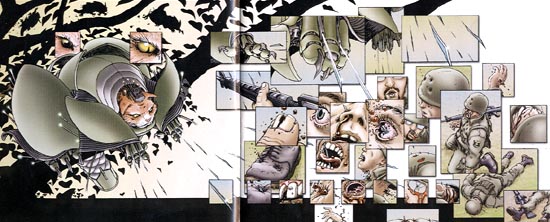
With the conclusion of We3, many people would encourage interested parties to wait for an eventual graphic novel collection of the mini-series. I’ll go one step further and say that if at all possible, to pick up all three issues of the series now and read them. Being able to spread wide open the pages of We3 to catch every single line of Quitely’s art is a must, and Morrison has carefully paced each of the issues that they begin and end at natural moments, so that you both need to stop at the end of the issue to catch your breath and mentally decompress, as well as a desire to read the next issue to find out what happens next. Don’t get me wrong, when a collection is published I’ll almost certainly buy a copy so I can have it on my bookshelf in a nice sturdy format, but I can’t fault anyone for running out now and buying what’s available. We3 is the sort of book that can be described as depressingly beautiful. Everything works so perfectly here, and while it is certainly a work of beauty, it’s a kind of beauty that brings great sadness by design. It’s hard to not be touched emotionally by We3, and I thank Morrison and Quitely taking me on a most incredible journey. As a reader, you will be hard-pressed to find something better.
Purchase Links:
